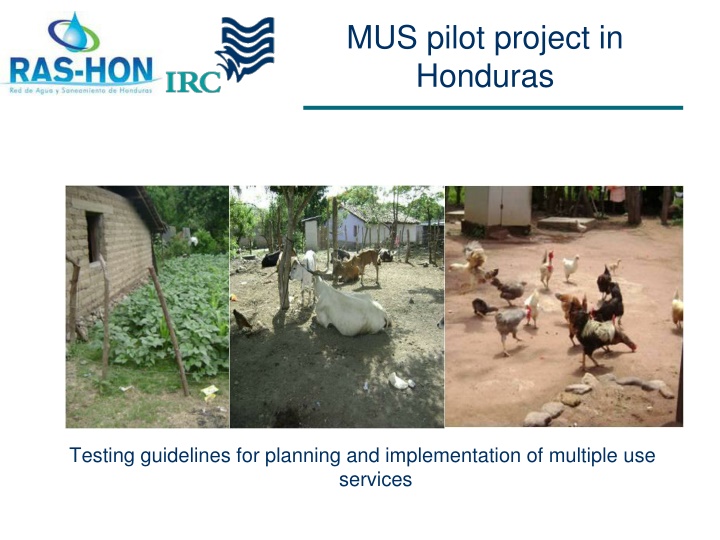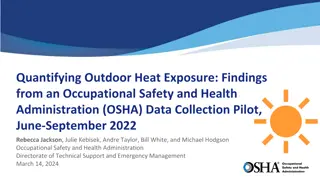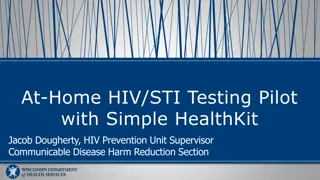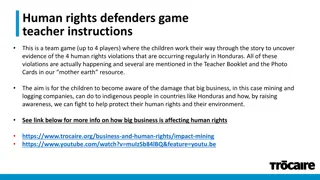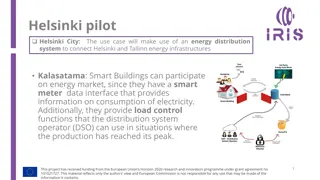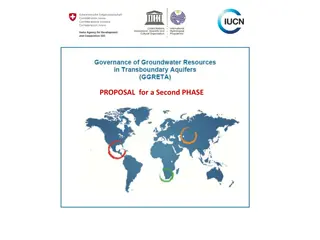Testing Guidelines for MUS Pilot Project in Honduras
Assessment in Honduras showed impacts of Multiple Use Services on livelihoods. Measures for sustainability include rules, tariffs, and alternative sources. Recommendations include promoting MUS in existing and new systems for sustainability and equity. Pilot projects were implemented to assess integration of MUS in project cycles, leading to guidelines for planning and implementation.
Download Presentation

Please find below an Image/Link to download the presentation.
The content on the website is provided AS IS for your information and personal use only. It may not be sold, licensed, or shared on other websites without obtaining consent from the author.If you encounter any issues during the download, it is possible that the publisher has removed the file from their server.
You are allowed to download the files provided on this website for personal or commercial use, subject to the condition that they are used lawfully. All files are the property of their respective owners.
The content on the website is provided AS IS for your information and personal use only. It may not be sold, licensed, or shared on other websites without obtaining consent from the author.
E N D
Presentation Transcript
MUS pilot project in Honduras Testing guidelines for planning and implementation of multiple use services
Background In 2008, assessment of multiple use of water in 14 communities in Honduras which showed that MUS allows obtaining livelihood benefits, but with different degrees of impact for different user groups This is made possible to some extent due to over-design of existing infrastructure and a relatively high water resources availability It may have some impact on sustainability of services, but other factors are much more significant A range of measures were found that are put in place to ensure more sustainability and equity in service delivery, such as internal rules, differentiated tariffs and the use of alternative water sources, beyond the main water supply
Background The study recommended: To support communities in developing local internal rules and regulations around water use for multiple purposes to improve sustainability and equity In rehabilitating existing systems, consider promoting MUS through: improving pipe networks, use overflow from tanks, and use obsolete infrastructure for productive purposes Develop new design parameters for new systems, based on actual consumption patterns
MUS Pilot project The results of the study were shared through RASHON (Water and Sanitation Network of Honduras), including to FHIS (Honduran Social Investment Fund), the government agency responsible for constructing water systems The idea for a pilot project was quickly conceived and approved within one of the WB funded water programmes: WB staff attended the inauguration ceremony of a water supply system in one of the communities At the walk through the community, it was observed that already on the first day the overflow of the distribution tank was used to irrigate potato fields This triggered many question of the WB staff on the future of the system. Why not develop a MUS system from the onset, to prevent unauthorised and unregulated water use for irrigation?
MUS Pilot project After this, FHIS proposed to carry out 2 MUS pilot projects, supported by the WB With the objective of assessing of what needs to change to the project cycle to include MUS in each of its steps Hence, the idea arose to develop a guideline for planning and implementation MUS to support these two pilot projects, but also for subsequent upscaling
MUS Guidelines Target audience: engineers, technicians and social workers, supporting the planning, design and implementation of rural water supply systems Consisting of 3 parts: Part 1: conceptual framework, summarizing key concepts and findings related to MUS Part 2: MUS in the project cycle: detailing for each step in the cycle how to address MUS and which tools to use for that purpose Part 3: tools. This provides an overview of different (participatory) tools and methods to address MUS in each step
Project cycle Post-construction support Identifying demand Evaluation Implementation Assessment Design Studying feasibility of alternatives
Assessment Objective: to get a detailed understanding of actual multiple use practices, their impact on sustainability of existing water systems and possibilities to improve these Key issues to address in this step include: identifying user categories, their different water use patterns, and availability of water resources and existing infrastructure Tools: User categorization Community mapping Inspection of existing infrastructure Water resources assessment Analysis of water consumption pattern Focus group discussions with water committee and users
Feasibility of alternatives Objective: to analyse the technical, financial and social feasibility of varies (conceptual) intervention alternatives, and agree on which ones to elaborate in a detailed design Key issues: design parameter implications, cost implications, analysis of alternatives Tools: Identifying which design scenario to follow: Scenario 1: productive use is insignificant compared to other domestic uses now and probably in the future. Conventional design parameters can be used Scenario 2: there is some productive water use, which is likely to grow in the future. However, it is not necessary to develop a specific MUS design, as the amounts of water needed fit within existing design parameters. However, there is need to develop specific internal regulations around water use Scenario 3: there is a significant amount of water used for production and this is likely to increase in the future. Specific design parameters need to be considered and specific infrastructure may need to be developed for this. Besides, there is need to develop specific internal regulations around water use Technology selection tools Community meeting to analyse and select alternatives
Table used for typical consumption patterns User category Types of productive use Median consumption for productive use (l/p/d) Range of productive consumption from the water supply systems (l/p/d) Median consumption for productive use from water supply system(l/p/d) People working outside agriculture Some small animals and trees 2.7 1-20 2.7 Subsistence farmers Some animals (chickens, cows, pigs) and a backyard garden 12.3 1-60, with some users > 200 11.0 Small and medium farmers Farm animals, irrigation of vegetables and backyard gardens, processing coffee 135.0 1-150, but some users > 150 40.3 Big farmers Crop irrigation and livestock 483.7 0-200 67.3 Cattle ranchers Water for large number of livestock, pig and poultry farms, fish farms 280.0 20-200 87.5 Businesses Water for small and medium industries, such as brick making, hotel, and cheese making 82.7 1-125 8.0
Progress on the MUS pilot project Activities carried out so far: Training and discussion workshop with engineers and technicians to get inputs for the guidelines Development of the guideline document Selection of communities where the guidelines would be tested Further induction of engineers and technicians Applying the assessment and feasibility steps of the guidelines in 6 communities in the Department of La Paz
Case of guideline application Community: Culizanba, La Paz Number of households: 37 Population: 246 persons Type of water source: surface water Currently, there is no formal water supply system; people use hosepipes from the river to their homestead
Example of design calculation User category Subsistence farmers Small and medium farmers % population 41% 59% Median productive use from water supply systems(l/p/d) Median productive use from water supply systems(Galons/p/day) Median domestic design norm(Galons/p/day) 11 40.3 2.91 10.65 25 25 Average design supply (Galons/p/day) Total supply (Galons per day) Total supply for community (Galons per day) 27.91 2196.75 6234.75 35.65 4037.99 Average supply (Galons per person per day) 32.47 Usual design norm in Honduras: 30 Galons/p/day
Selection of feasibility of alternatives In order to facilitate MUS, this community needs a design supply of 10% higher than what normally would be used as design norm Not yet an assessment of cost implications, but probably very modest cost increase
First lessons learnt The guideline allows to systematically assess the community demands and expectations But in order to capture those, a good level of trust is needed between community and the outside engineers and technicians The quality of the application of the guidelines also depends on the skills and attitude of the engineers and technicians: they demand more openness and creativity When presenting alternatives, it is important that the community understands both the benefits and the cost implications of each alternative One difficulty in applying the guidelines is still the extrapolation of actual water use patterns to expected future needs
Multiple-use services are all about changing perspectives .
